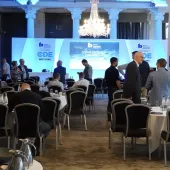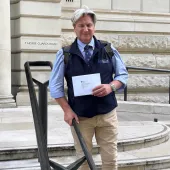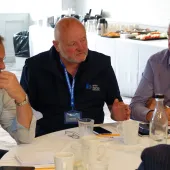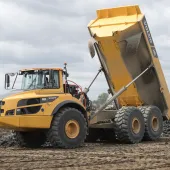BAA Annual Conference 2018
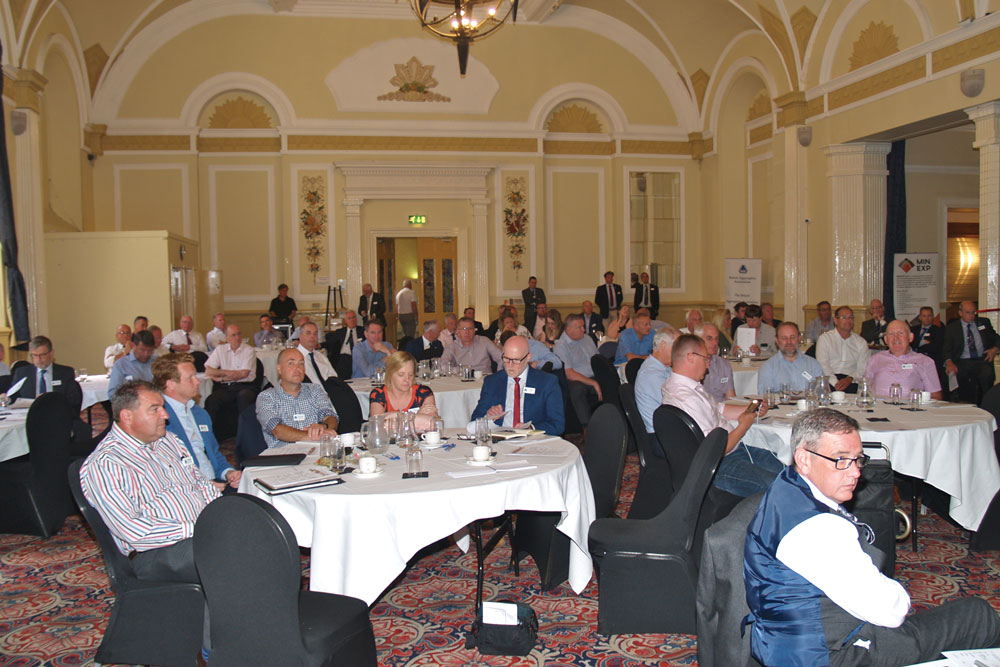
First published in the August 2018 issue of Quarry Management
Report on the British Aggregates Association’s 2018 seminar proceedings
White, British and male. That’s the profile of 90% of people working in the minerals extraction sector in the UK. And their average age is 55, with just 17% in the 18–34 age bracket.
The proportion of 16-to-64-year-olds employed in the UK is already the highest it has been since records began in 1971 and it is forecast that the UK workforce will fall by a million in the next decade.
That was the scene set by Anthony Elgey, general manager of MP Futures, part of the Mineral Products Qualifications Council (MPQC), when he spoke at the British Aggregates Association (BAA) annual meeting, held at the Palace Hotel, Buxton, on the day before the opening of the Hillhead exhibition.
MP Futures has taken on the role of key business partner for the sector to develop new apprenticeships. It is also the main sponsor for the Inspiring Futures project, through which volunteers from the industry go out to schools and colleges to try to guide youngsters into the industry.
Mr Elgey said that in spite of the looming labour shortage and the fact that 60% of MPQC members have vacancies now, only 22% of those in the minerals products sector had developed any contact with schools or colleges.
Apprenticeships will play an important part in making sure the industry has enough people to fulfil its vital role supplying the construction industry, especially if the Government’s ambitions for infrastructure improvements and house building at 300,000 units a year come to fruition.
In a jobs market competing for eligible workers, the quality of those apprenticeships will be important. Mr Elgey said apprenticeships had to regain the reputation they once enjoyed for high-quality training and career opportunities.
Neither could they be seen as being exclusively for young people. ‘We have 16-to-60-year-olds on apprenticeships,’ he said.
He ran through the different apprenticeships available in England, Scotland and Wales, which are all a bit different from each other. He spoke about the Higher Apprenticeship in conjunction with the University of Derby and said there were other apprenticeships on the way for Weighbridge Operations and Laboratory Sampling and Testing, Plant Maintenance and Engineering was in development.
He told the operators at the annual meeting that MPQC was their business partner in apprenticeship design, development and delivery for high-quality apprenticeship training.
There were hard-hitting criticisms of the Environment Agency by Mark Pritchard, a partner at GWP Consultants and a chartered mining engineer with 28 years’ experience in mineral resource assessment.
He described the Environment Agency’s performance in areas of inert landfill as ‘unsatisfactory’ and called for regulations that are ‘consistent, proportionate to the risk and regulated by competent staff’, all of which he felt was currently lacking.
He said the Agency was not protecting the environment but just regulating what was easy to regulate. ‘The situation since I first started giving this talk in 2010 has not got any better – in fact, it’s got worse.’
He added: ‘In my experience, I find the Environment Agency falls well short of what might be considered a competent organization.’
He felt regulatory control was ‘beyond the experience and qualification of some of the Environment Agency staff’. In one case he had dealt with a criminal prosecution for excessive dumping on a licensed site was instigated on the basis of measurements taken using aneroid barometers – a piece of equipment more commonly used in the 1960s. The case was thrown out by the court in three days. ‘What was the benefit of that legal action in protecting the environment?’ he wondered.
He wanted to think it was coincidence that site visits tended to be on dry, sunny days to sites nearest Environment Agency officers’ home bases. ‘There are sites with no history of non-compliance that get a lot of visits. Why?’
He complained about the Agency’s insistence on so many waste gas monitoring boreholes on covered refuse sites. The agency might require 70 or 80 for a site reclaimed for agricultural use where there was no risk. Again he asked: ‘Why?’ And the requirement was inconsistent, with different Environment Agency offices having different requirements.
Chris Tofts tried to provide a clearer view of the future for minerals planning. He is a partner at minerals industry consultants Stephens Scown, where he heads the planning team and specializes in minerals-specific and environmental matters.
He said changes to the National Planning Policy Framework (NPPF) were being made at the end of July. They would make the interpretation of legislation stricter, although clearly focused more on house building than on minerals extraction.
Notably the changes removed item 142, which says: ‘Minerals are essential to support sustainable economic growth and our quality of life’.
They also remove the second part of item 145, which requires identification of landbanks to satisfy demands for seven years for sand and gravel, and 10 years for crushed rock. Coming out is the section that says: ‘Longer periods may be appropriate to take account of the need to supply a range of types of aggregates, locations of permitted reserves relative to markets, and productive capacity of permitted sites’.
In greenbelts, Mr Tofts believed minerals extraction permissions would become harder to obtain, although they will not be considered inappropriate as long as they preserve the openness of an area, whether they are for an extension to an existing works or not. Quite how that is interpreted remains to be seen.
Mr Tofts also mentioned section 66 of NPPF, which requires planners to consider the ‘settings’ of listed buildings.
What consitutes a setting? He cited the case of a wind turbine proposed for a site 1.5km from a listed church and hidden from it by a hill. Planning permission was withheld because both the church and wind turbine could be seen from some locations.
He concluded with the requirement of community funds to be targeted, not simply put into a general fund. In order to be a consideration of planning, the fund has to have a real connection to the development and address an issue related to it.
There was, as ever at the BAA annual meeting, an extensive line-up of speakers, each given 10-minute cameo spots in which to highlight the products and services they offer, followed by two longer presentations in the afternoon, this year given by Miles Watkins, the departing President of the Institute of Quarrying, and Patrick Louis, a Swiss entrepreneur, businessman and business-turnaround specialist who, from 2010 to 2014, was chief executive officer of the Lotus Formula 1 racing team.
The Institute of Quarrying celebrated its centenary last year and at the BAA seminar Mr Watkins took the opportunity to look forward to the next 100 years, now under way, even though he said he would be stepping away from IQ when he stood down as its President, having first joined its Council in 1998.
He said: ‘It’s been really fun being President.’ One of the aspects which pleased him was the change in the way the Institute is governed, giving it a good foundation for the start of its second century. He said the BAA had always been supportive of IQ.
Looking foward, he said the future was digital. ‘Embrace the digital age because it’s totally upon us.’ IQ had to use that medium for generating training material for life-long learning. If quarries signed up their people to the IQ, the Institute would make them more professional.
‘It’s not all about breaking rock. You need to be a rounded individual to make your way through life,’ said Mr Watkins, going on to explain how IQ is helping to provide life skills as well as quarrying skills.
All those skills are important because even in a digital age, minerals extraction is as relevant as ever. ‘Maybe one day someone will come up with an alternative to what we do, but I don’t see that happening any time soon,’ said Mr Watkins.
Patrick Louis had the message that whatever you do, it is your team that delivers it. ‘Everything is about people,’ he said, as he provided a fascinating insight into the working of Formula One car design and development, where millimetre adjustments can be the difference between winning and losing.
Having been introduced by Max Vermorken of SigmaRoc, and with a plethora of detail at his fingertips, Mr Louis explained how he had introduced performance measuring to the design team and on the factory floor of Lotus. Nobody wanted to be the worst designer or the worst performer in the factory and efficiency had improved.
The 10-minute cameo presentations that preceded the longer presentations had included:
- David Taylor from Command Alkon speaking about software from the company to streamline and manage dispatch and ticketing. He presented a single integrated software package that includes an app for sales teams’ phones to give them all the information they need to provide quotes to customers and follow up those quotes. In doing so, the information also goes straight to the quarry.
- Jo Cassidy from Powerscreen talking about the future of screening and crushing, saying ‘everything is about the matrix now’. For Powerscreen that means Pulse remote-monitoring telematics. ‘Knowledge is power,’ said Mr Cassidy, ‘and Pulse not only gives you information but also interprets it to enable you to get maximum efficiency from your crushing and screening plant.’
- Roy Bush and Mike Phillips introduced the new consultancy they have formed called MinExp to help the mineral processing and mineral extraction industries comply with health and safety requirements. Roy Bush said: ‘If health and safety is getting in the way of your business there’s either something wrong with your business or there’s something wrong with the way you are doing health and safety.’
- John Southall from the company that bears his name, which he established in 2003, said health and safety was in the cloud and he could put it there. It would connect to everyone who needed to carry out checks, remind them what to do and when, and require them to record what they had done. It is all automatic and reports back to management, providing reassurance that everything has been done and is up to date.
- Trevor Herbert from Mitsubishi spoke about energy saving and overall equipment efficiency (OEE). Again, it is all down to computing power and the Internet of Things, variable-speed drives and smart condition monitoring. His point is that relatively small adjustments can make a big difference. For example, if you can reduce the speed of a pump by 10%, the energy needed is 72% of that required at full speed. Reduce it by 20% and you have halved the energy needed. He gave an example of a variable-speed drive on a 30kW pump where the flow had previously been regulated by a valve. It reduced the energy used by 78%. And the benefits of condition monitoring on wear parts is well rehearsed.
The small exhibition associated with the BAA annual meeting saw stands from Archaeological Research Services, GWP Consultants, Herbst Software, Influential Management, MinExp, Mitsubish Electric, Rural Arisings, Nature After Minerals (NAM) and Southalls.
- Subscribe to Quarry Management, the monthly journal for the mineral products industry, to read articles before they appear on Agg-Net.com



